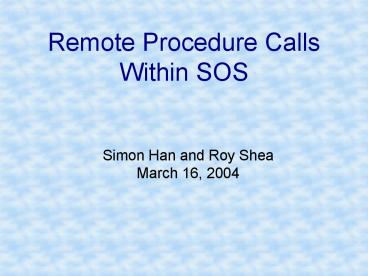Remote Procedure Calls Within SOS - PowerPoint PPT Presentation
1 / 13
Title:
Remote Procedure Calls Within SOS
Description:
Motes have limited memory and processing capabilities ... Stresses limited mote processing power. Easy to compute on more powerful nodes ... – PowerPoint PPT presentation
Number of Views:37
Avg rating:3.0/5.0
Title: Remote Procedure Calls Within SOS
1
Remote Procedure Calls Within SOS
- Simon Han and Roy Shea
- March 16, 2004
2
Sensor-network Operating System SOS
- Targets the dynamic needs of sensor networks
- Allows insertion of new modules onto deployed
sensor nodes - Modules on a node communicate through SOS core
using messages - Customization of applications can reduce sensor
node load
3
Motivation for an RPC Mechanism
- Motes have limited memory and processing
capabilities - Expensive to transfer modules through sensor
network
- Hardware and software heterogeneity should be
exploited
4
Driving ApplicationVoronoi Polygonization
- Useful abstraction in sensor networks
- Requires heavyweight computation on floating
point numbers - Stresses limited mote processing power
- Easy to compute on more powerful nodes
- Good candidate for RPC
5
Message Passing in SOS
- Procedures post messages to the SOS core
- SOS core routes message to correct module
- Message carries state needed by module
- Message format facilitates a transition to RPC
6
Split Remote Procedure Call (S-RPC)
- Wireless sensor networks are event driven
- Computations are typically modeled as two
function calls instead of one - SOS uses FIFO non-preemptive scheduling
- Blocking procedure call is impossible
- Masking out failures in RPC itself is hard
- E.g. network failure, server mobility
- Transparent procedure call and return becomes
unnecessary
7
Changing SOS to Support S-RPC
- Make message passing network capable
- Enhance SOS core to notify unserviceable messages
over network - Implement basic cache for RPC handlers
- Evaluate cache aging policies
- Write simple protocol to find RPC handlers in
network - Modified SOS message format
SOS Msg
TOS Msg
8
Life of S-RPC in SOS
- SOS core notes if message is addressed to an
unknown module - Core checks local cache for remote handler
- Enters resource location protocol if cache misses
- Core redirect message to remote destination for
handling - Remote destination handles RPC as normal message
then reply result to source module
9
Sample S-RPC Session
Node N
Node M
Module Y
Module X
SOS Core
SOS Core
- Module X generate message for Module Y
- Core sees unregistered destination in message and
checks RPC cache for Module Y - Cache hit says Node N has Module Y
- Message redirected to Module Y on Node N
- Module Y handles message and returns it to Module
X on Node M
RPC Cache
RPC Cache
10
Fault Handling in S-RPC
Node N
Node M
Module Y
Module X
e
d
SOS Core
SOS Core
f
d) Module Y not found, MSG_ERROR is sent back to
Module X. e) Cached RPC destination no long
valid. Resulted as another RPC. f) SOS Core
notifies source to invalidate the cache.
MSG_ERROR is then sent back to Module X.
RPC Cache
RPC Cache
11
Energy Trade Offs
- Blink is a small application run often (1 / sec)
- Blink RPC packets quickly outweigh cost of
transferring module
- VISA is a very large module run rarely (1 / day)
- May take a long time for RPC packets to outweigh
cost of transferring module
12
Future Work
- Improved cache maintenance
- Aging of cache entries
- Entry evocation policy
- Examine mechanisms to find RPC handlers within
the sensor network - Examine policies between code migration and S-RPC
- Fault tolerant mechanisms
- RPC timeouts
- Forcing module transfer if no handlers found
13
Conclusions
- RPC allows SOS to exploit network heterogeneity
- Offload difficult computations to more powerful
nodes in tiered network - Use diverse sensors on neighboring nodes
- Core design of SOS facilitated transition to RPC
- Individual applications need to evaluate energy
trade offs of module transfers and RPC messages































